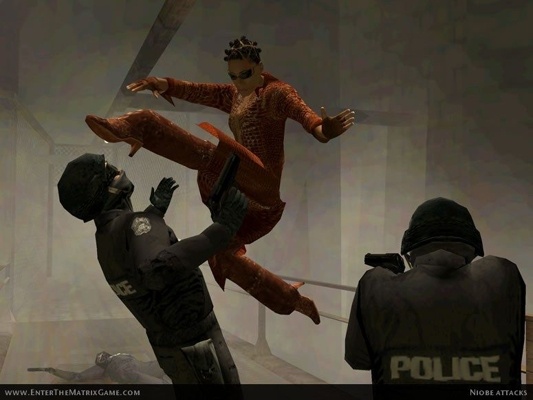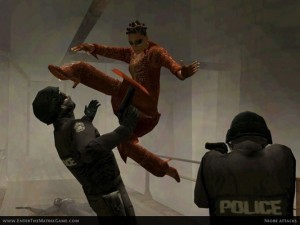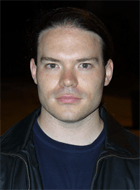
 Archival interview with Gabe Rountree from the official Matrix website.
Archival interview with Gabe Rountree from the official Matrix website.
BACKGROUND
Matrix: What first allowed you to jump into the video game industry professionally?
Gabe: I got lucky. I was programming when I was sixteen, and got my first programming gig that way… when I realized that this wasn’t it for me. Then I saw an ad for a game designer at a video game company and I found out many years later I only got that job because I had long hair and all the other applicants did not; they didn’t think they looked ‘video game’ enough. I found it was very much the industry for me, it’s a very informal, very artistic industry. Everybody wears a million hats, does a million things. Most people have an opportunity to work on something creative on a video game, as opposed to a movie set where there are a dozen people who are truly creative, and everyone else just does their job.
About five years ago I got into one of the first motion capture houses, which got me started using motion capture in video games. It just led on from there with a couple of different companies, and I finally ended up at Shiny [Entertainment] with an amazing group of people who are very artistically talented; that’s where I’ve stayed.
Matrix: Talk about some of the games you’ve worked on.
Gabe: Recently we did a game called Messiah which, while artistically amazing, didn’t sell too many because its content was a little edgy. However, Larry and Andy [Wachowski, Writers / Directors of THE MATRIX trilogy] saw it before the first MATRIX movie was released, and they offered us THE MATRIX game, but at the time our parent company didn’t want us to do a movie based title, so we were saddened as we couldn’t take the title. Larry and Andy offered the game to us again after they’d talked to all the giants, so we feel very lucky. The reason they came to us was because we do small artistic titles and we’re very careful about making sure that everything is beautiful and always has an engaging story.
One of our most recent releases is Sacrifice, which is a PC multiplayer game where you play a wizard and generate your minions. You’re able to summon them by using souls, and the only way you can collect more souls is to defeat your enemy and sacrifice their souls to your own god. A little racy subject matter, but it is definitely the most beautiful game I’ve seen in many years; the art direction is absolutely amazing.
 Matrix: Compared to a game like Messiah or Sacrifice, how would THE MATRIX video game rate as far as scope of the production work?
Matrix: Compared to a game like Messiah or Sacrifice, how would THE MATRIX video game rate as far as scope of the production work?
Gabe: This is definitely the largest project Shiny has ever done. Our entire company has devoted itself significantly to this project. Normally we do two games back to back: we do one and it gets released while another one is being done. This, by the time we’re done, will most likely be the most expensive video game ever made. It has scope, and you have an incredible story, written by Larry and Andy. The video game touches the movie, it’s an integral part. If our characters don’t do what they’re supposed to, if they don’t complete their missions, then Neo fails, the Matrix stays, Zion falls, and humanity can no longer survive.
Matrix: What does your role as the Animation Director on THE MATRIX video game entail?
Gabe: It entails running with ideas Larry and Andy had for the game, alongside the script we got from them. A big part of my responsibility is to make sure the characters do what they’re supposed to, and in such a way that the performances are much more cinematographic. Under Larry and Andy’s direction, I have been directing some of the motion capture for the video game.
MOTION CAPTURE
Matrix: What is motion capture, and how will it be used in the game?
Gabe: All mocap does is take a person’s movements and record them. In this case we’re not including faces (which we’re doing at another point), but if I move my arm like this, my movements are recorded exactly. Then I can take that gesture, put it on the game character, and the game character will do it exactly.
As we all know, actors and animators don’t exactly match up, often times the video games are wooden and stiff – you just don’t have that feeling you get from a movie, there’s no drama, there’s no acting. Here, we have the performances of incredible stars: we had Carrie-Anne Moss [Trinity] in the other day, we have worked with Jada Pinkett Smith [Niobe], and we’ve worked with Anthony Wong [Ghost]. We are working with all these amazing stars who are complete professionals. They’re cast for THE MATRIX sequels, so they must be incredibly good, which means we have a performance level no one else can match, and probably won’t be able to match for years… no one is going to be doing this for a while, this is a first.
Matrix: How much time have you spent on the location of filming itself?
Gabe: Tomorrow will be eight weeks, not that I’m counting, but it is hard to work twelve to fourteen hour days on set. It’s amazing actually, I get here tired and rundown in the morning, and the second I step out there I’m awake, because that is something I didn’t think I would have the opportunity to do, to work with amazing people like that.
Matrix: Actors don’t typically do motion capture, what has been their reaction?
Gabe: I’m amazed at how well the actors have taken to everything, although there’s a little bit of feeling uncomfortable at the beginning because they wear a skintight suit. When Jada comes in she calls the motion capture rig “the imagination cave.”
As an actor, there’s nothing around you, you have to imagine that this is here and there’s a gunman over there, and you have to react to it. It’s a lot like Stage Acting, a big empty space to work within and nothing in the shadows but your imagination. In that way I think we’re using the entire range of their abilities. However, some of the actors did tell us that the most fun they had was on the mocap stage because we have no lighting, we have no sets, and we have no make-up. We do have costume, but the costume only takes fifteen minutes to get into. It’s exhausting because there are no hours of down time, but at the same time they’re not sitting around in their trailers and they get to work on their craft every minute. So I think they enjoyed it… or they fooled me convincingly.
Matrix: Are you also working with less experienced actors?
Gabe: We’re working with top stars and a few people who are lower level actors to fill in the gaps for background characters, like cops and secretaries. It’s one of those things where you do have to give much more direction to somebody who isn’t as experienced. We started with a few of the less experienced actors, and I worked very hard with them to make sure we got everything going in the right direction. For Jada, two sentences set the scene, but for someone else it might take a few minutes of discussion for them to understand the scene.
It’s amazing how you can just you give some actors the scene and all of a sudden they’re someone else. There’s no work, there’s no effort, they don’t have to struggle to become someone else to make sure you get that performance. Jada is Niobe when she comes on set. She comes in and she’s smiley, happy Jada, then all of a sudden she’s serious, no-shit Niobe, and she’s our hero. Cut, and she’s back to herself, there’s no delay, but she’s completely and utterly Niobe for those times.
Matrix: What is the additional mocap that will be done in Australia?
Gabe: It will be facial motion capture. We’ll be gluing little markers to the actors’ faces, which will capture the full movement of the face, as the face really is the most expressive part of the body. If you see bad acting, you know it, it’s not a person, it’s a wooden mannequin. That’s why we have to do this, it’s something we’ve been planning for quite some time. In Australia the actors are going to act their scenes again, but just for the audio and for their facial movements. Everything they do, every small emotional nuance they express facially, will show up on the character.
Matrix: Has facial capture been done before?
Gabe: For movies. There have been some tests done for it, but I don’t know if any video games have done it, and if they have it’s not been done well enough to be noticeable.
For movies. A few video games have done it, but not with the quality of Actor’s that we have. That kind of performance comes right through.Will those moments recorded in facial capture include playable moments?
They’ll include playable moments, although they’ll mostly be for the acted scenes where the characters have emotional interactions. We’ll also record them responding to situations, from angry to happy to sad to shock. That way, as the game progresses and the character reacts to the scene around them, we’ll record the actor reacting in shock, and will get how they’d actually do it. It’s amazing how everyone says and does things differently. If you actually look at individuals, there are all these twitches and little things people do that you never notice… until they’re gone.
Matrix: How much do you reference the first film?
Gabe: I’ve seen THE MATRIX probably over a hundred times at this point. I still enjoy it though. The Matrix is so complex that I still notice new things each time I see it.Now that you’ve been here for eight weeks on the location of THE MATRIX 2 and 3, what do you think they’re going to be like?
All of it is amazing; I’ve never seen anything like it. It’s going to set new records for everything. I think the only reaction anyone is going to have when they see the movie is awe, because some of these things are absolutely incredible. I think the movies are going to set new standards, somebody’s going to be walking away with another Oscar for Visual Effects.
Thanks Gabe.
May 2001

Be the first to comment